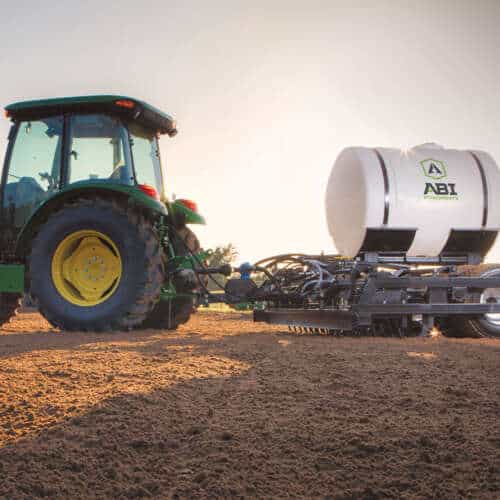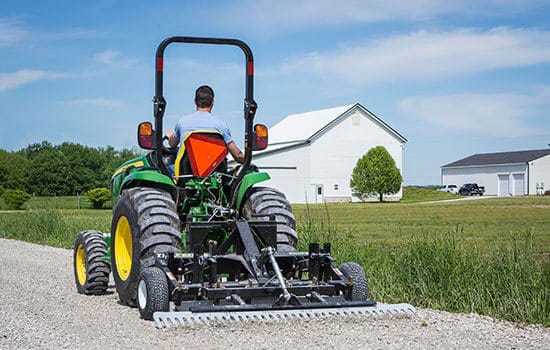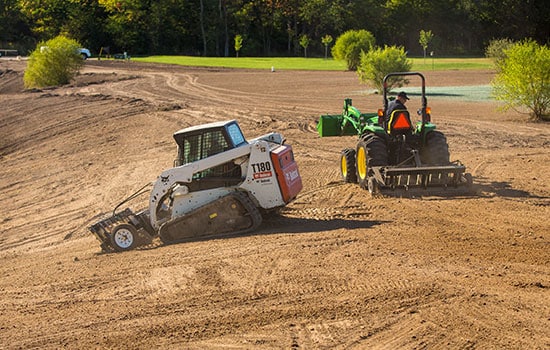How to Add Footing to an Arena – ABI Dirt
ABI Products Shown In This Video

ABI DragMaster Elite
- The World's Finest Arena Drag
- 8', 10', 12', & 16' Widths - Commercial-Duty
- Starting At: $534/mo.*
Transcript
Hey, everyone, Matt Metzger here with ABI attachments. Welcome back to another episode of ABI Dirt. On today’s episode, we’re going to talk through some basic steps on how to add new soil to your arena.
A couple of weeks ago, Kate Gorski. And I went down to the Agricenter ShowPlace Arena outside of beautiful Memphis, Tennessee for the Friends of Reining Futurity Derby. While there, we caught up with our good friend E.J. Allison, who was working the ground at that show and was adding new sand to that facility’s outdoor arena.
Now, a lot of you, while talking with our factory reps and service technicians, have asked us, “How do you work in new soil?” because you’re thinking that old footing of yours needs a little improvement. So over the next couple of minutes, we’ll keep it brief and keep it basic, we’re going to talk through some basic steps to get you pointed in the right direction.
Before we begin, I’ve got two disclaimers for you. First up, I want you to clarify your expectations. If you expect your personal backyard arena to look like the Lazy E or LA Equestrian Center then I strongly recommend that you pause this video and call an arena installation professional. Those big facilities spend hundreds of thousands of dollars procuring some engineered soil so that they can host world-class shows. If that’s what you want, no problem, but this DIY recommendations that we’re going to give you in the next couple of minutes probably aren’t for you, work with a professional to get a consultation. However, if you don’t plan on being the next Trevor Brazil or Dan James, you likely have all of the equipment you need to add in some new soil to your arena.
Disclaimer number two: the next couple of tips assume that you know the kind of soil that you currently have in your arena and you already know what you need to add to it. I’m not going to offer professional advice here on what you’re walking on and what you want to walk on. You need to do a little bit of homework and know if you’ve got heavy sand, to add clay, or if you’ve got heavy clay to add sand back. Those ratios, those numbers are very customized to individual arenas, we’re just talking the basic steps on how to work in the new material that you’re working with.
Once you know the kind of soil you need in your arena, here are a couple of tips to get you going.
Tip number one: level out your arena. Make sure that you use your arena drag, a box blade, or your TR3 with floating a leveling blade to level out your arena before the new soil arrives. If you don’t, no matter how much vertical agitation you do, that new soil is just going to follow the contours of your current arena. So before the truck arrives, make sure to level your arena to the best of your abilities.
Tip number two: when that truck driver arrives, make sure the truck driver spreads out the new soil as much as possible when dumping it into your arena. And listen, I know that I know that sounds basic, but some truck drivers are used to dumping and running, they’re not familiar with the process of actually spreading out a material. So make sure they know before they back into your arena that she want them to do is back into the arena as far as they can go, slowly dump, and as they exit, spread out that rest of the truckload so when it comes to working in the material, it’s all a whole lot easier than a massive pile on one portion of the arena.
And that brings me to tip number three: once that material is spread out, vertical agitation is the name of the game. This is where you use those vertical agitating components on your arena drag to stir in and mix in that new footing. So whether you’ve got grooming rods or ripping teeth, get those engaged, pull other components out of the way because right now you’re just stirring everything in. We recommend using a tight circle pattern. And if you’re not familiar with that, just go back to your childhood days, imagine a slinky that you push over sideways and spread out, right? Those tight circles work, those tight circles up one side of the arena and down the other to really get a good mix in.
And that brings me to number four: don’t overmix. And I know that sounds counterintuitive, but depending on the particle size of the soil you’re dropping in, it could be possible for you to take that new material and work it all the way under the old and bring the old back to the surface. It just depends on what kind of soil you’re dropping. But if you do that, you’re putting a lot of money you spent on that soil and dropping it to the bottom and you’re not getting the benefit out. So don’t overmix, get a nice spread of water on top of it when you’re done, let those particle sizes bind together.
I hope these tips were helpful today if you’ve been considering adding new footing to your arena. Remember, if you want a world-class show arena, there are professionals to help you do that, but if you just want an improvement to your current situation, you likely have the ability to get it done. Use these tips, take a look at your arena drag, and if you are concerned that your current arena drag does not have the muscle to pull off the vertical agitation or it doesn’t have the ability to level, don’t be afraid to give our factory reps a call. Let us help you get matched up to an arena drag that can get the job done so you can upgrade that footing and enjoy the riding. Until next time, everyone, take care.



